Vision Pro Online Usage Survey Results
 Tom Krikorian
Tom Krikorian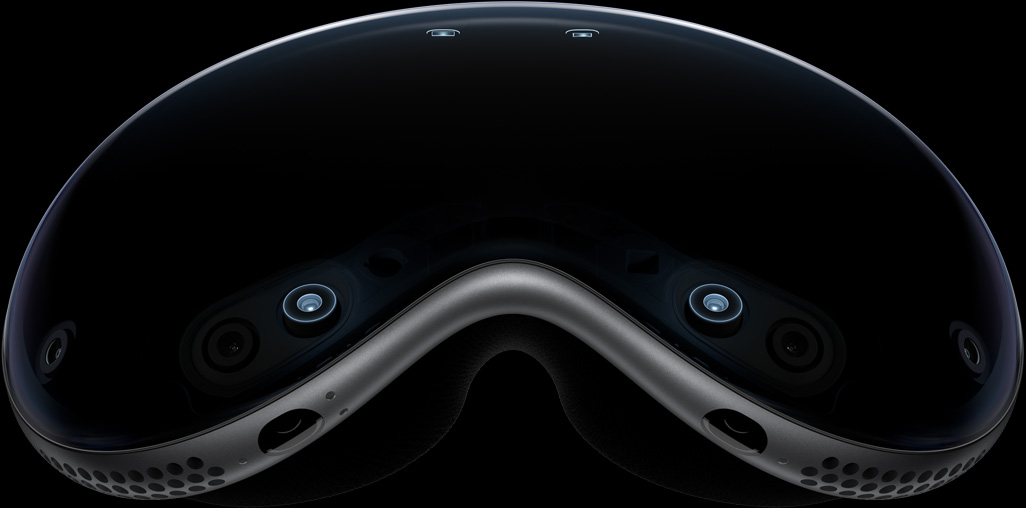
Introduction
I recently conducted a survey to better understand how people are using their Vision Pro. The survey, which ran from August 22nd to September 2nd, 2024, asked participants a range of questions about their experience with the device. These included:
How frequently they use their Vision Pro
What they primarily use it for
What they like about the device
What they don't like about it
I also wanted to get a better understanding of the demographics of early Vision Pro adopters.
To reach Vision Pro owners, I posted the survey across various online platforms, focusing on social networks and communities dedicated to discussing the Vision Pro. These included relevant groups and forums on Reddit, LinkedIn, Facebook, Twitter, and Threads.
The goal of this survey was to gather real-world insights from actual users, going beyond the initial hype and marketing to understand how the Vision Pro is being integrated into people's daily lives.
In this article, we'll dive into the findings from this survey, exploring how early adopters are using their Vision Pro, what they find most valuable about it, and where they see room for improvement. By looking at the data collected, we'll get a clearer picture of the Vision Pro's impact and its potential to shape the future of computing.
Results
Part 1: Usage
How long have users been using the Vision Pro?
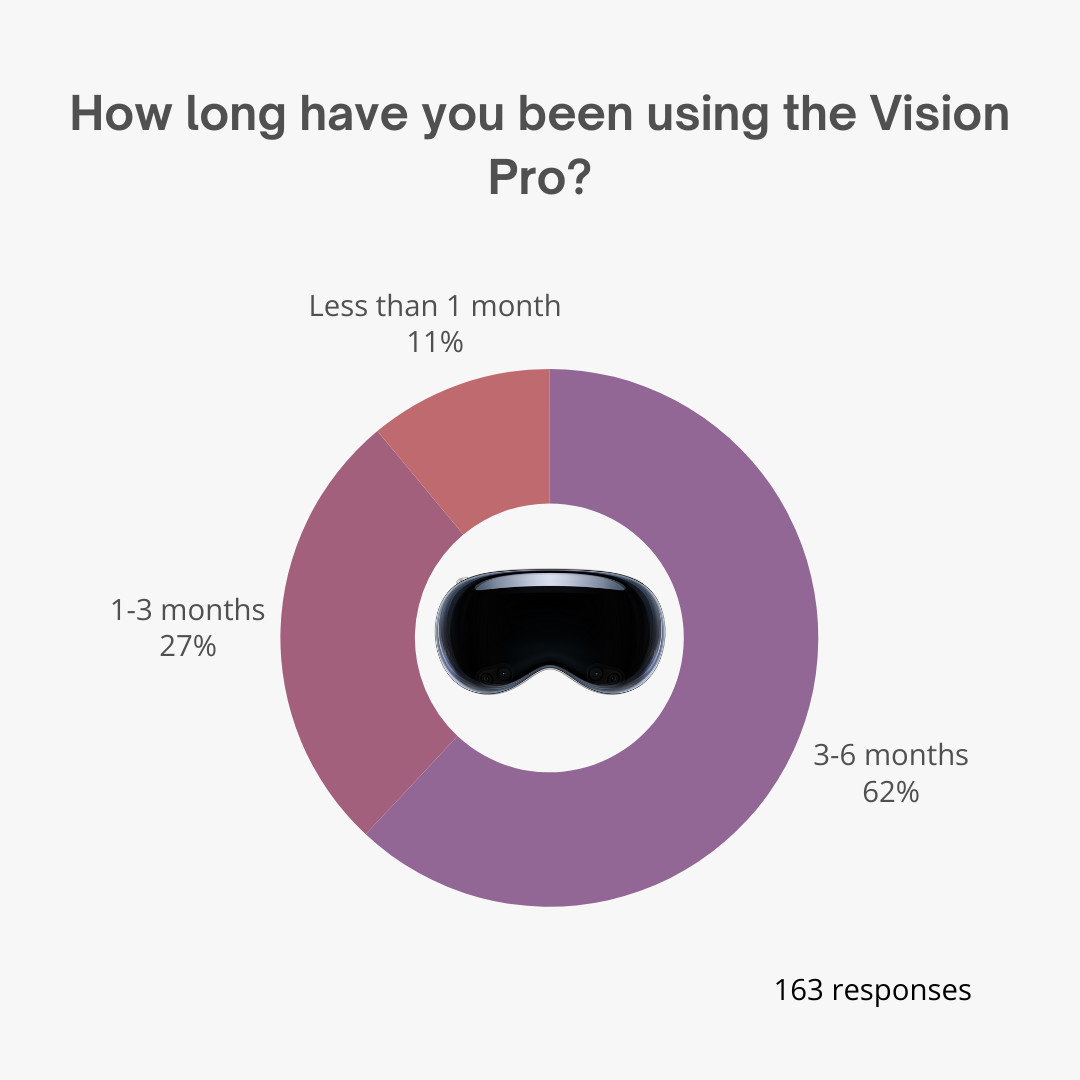
61.96% of respondents have been using their Vision Pro for 3-6 months.
26.99% have used it for 1-3 months.
11.04% have been using it for less than 1 month.
How often do users engage with their Vision Pro?
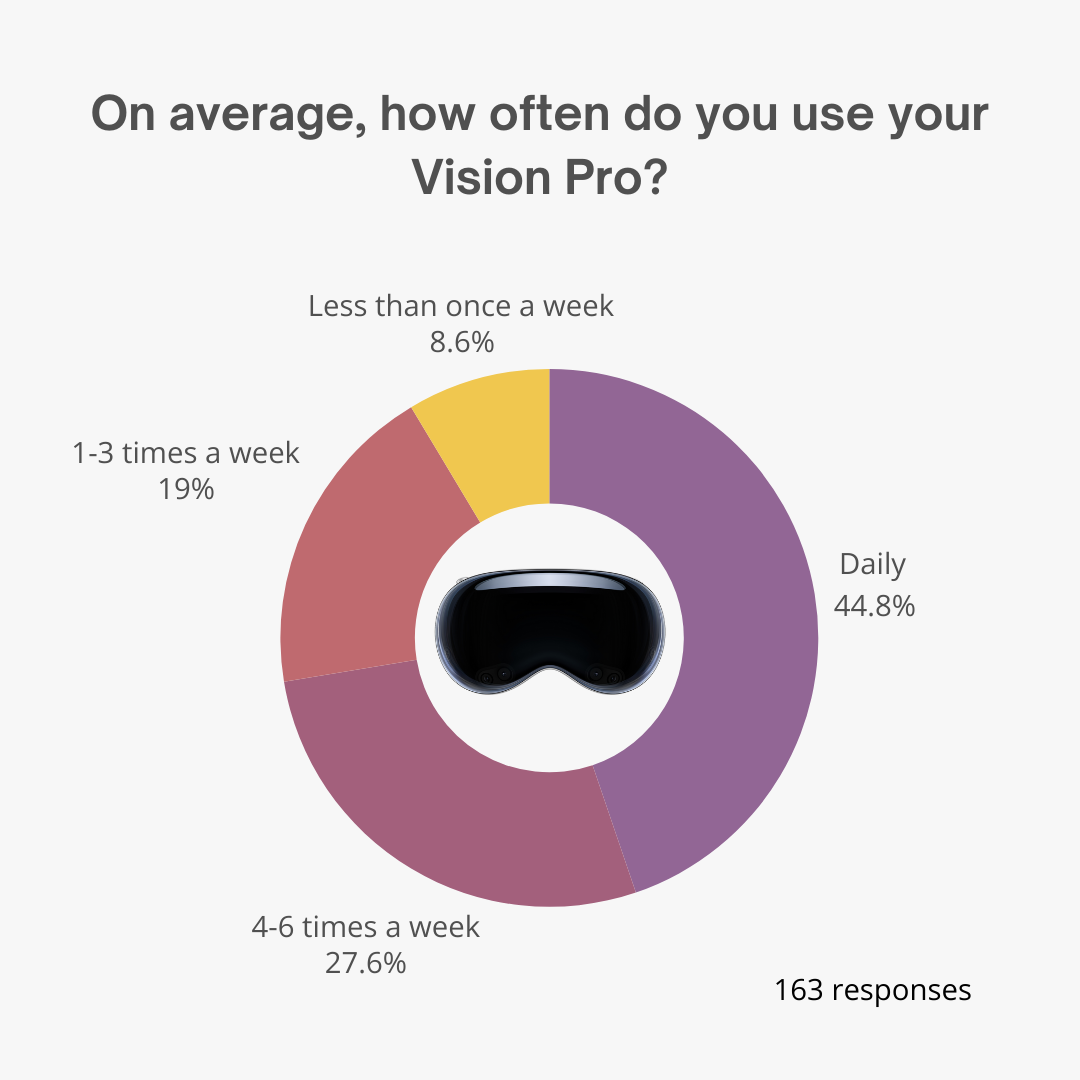
44.79% use it daily.
27.61% use it 4-6 times a week.
19.02% use it 1-3 times a week.
8.59% use it less than once a week.
How long do typical sessions last?
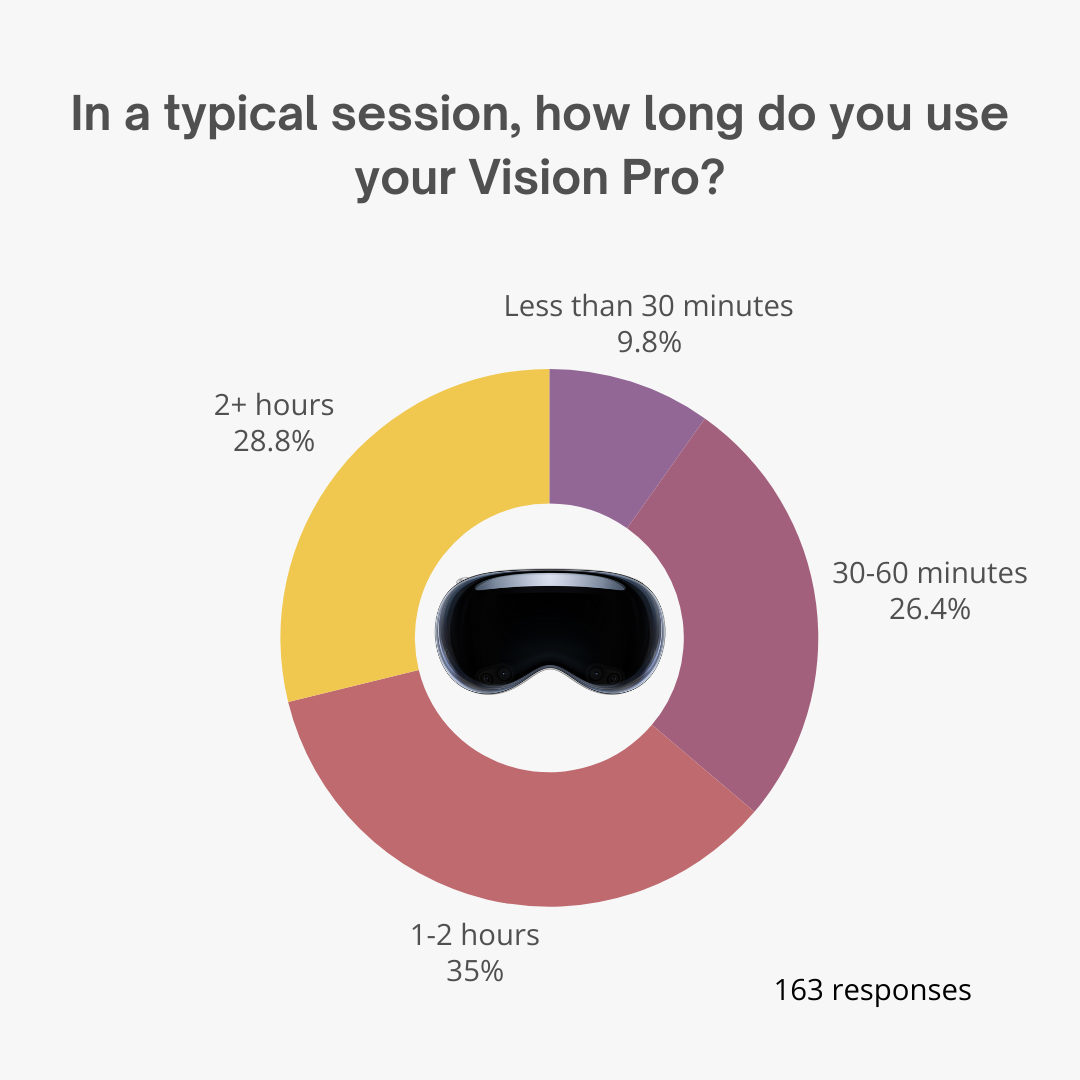
34.97% of respondents spend 1-2 hours per session.
28.83% engage for 2+ hours.
26.38% use it for 30-60 minutes.
9.82% have sessions of less than 30 minutes.
Part 2: Use Cases & Features
What are your primary uses for the Vision Pro?
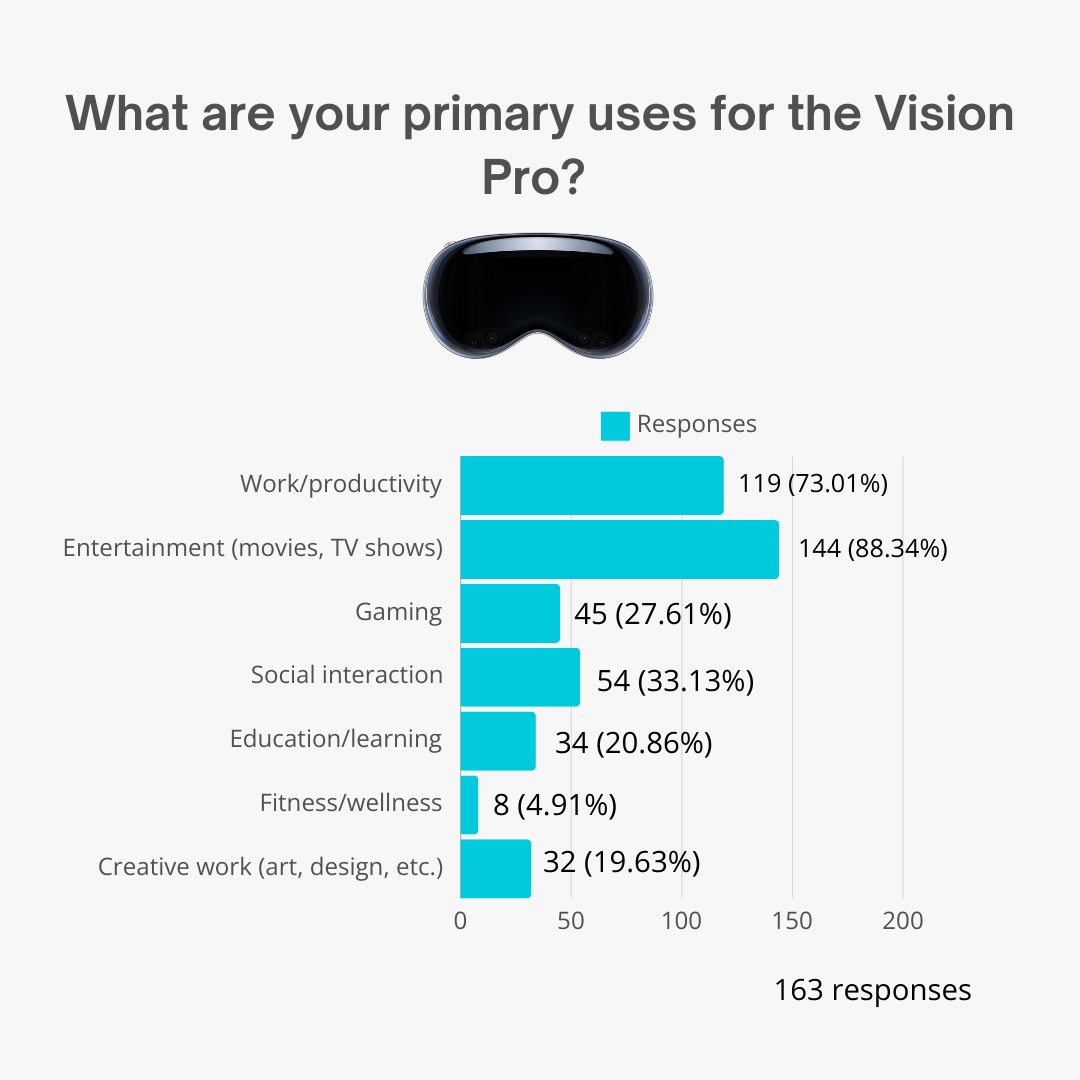
Work/productivity: 119 (73.01%)
Entertainment (movies, TV shows): 144 (88.34%)
Gaming: 45 (27.61%)
Social interaction: 54 (33.13%)
Education/learning: 34 (20.86%)
Fitness/wellness: 8 (4.91%)
Creative work (art, design, etc.): 32 (19.63%)
In which environment do you find the Vision Pro most useful?
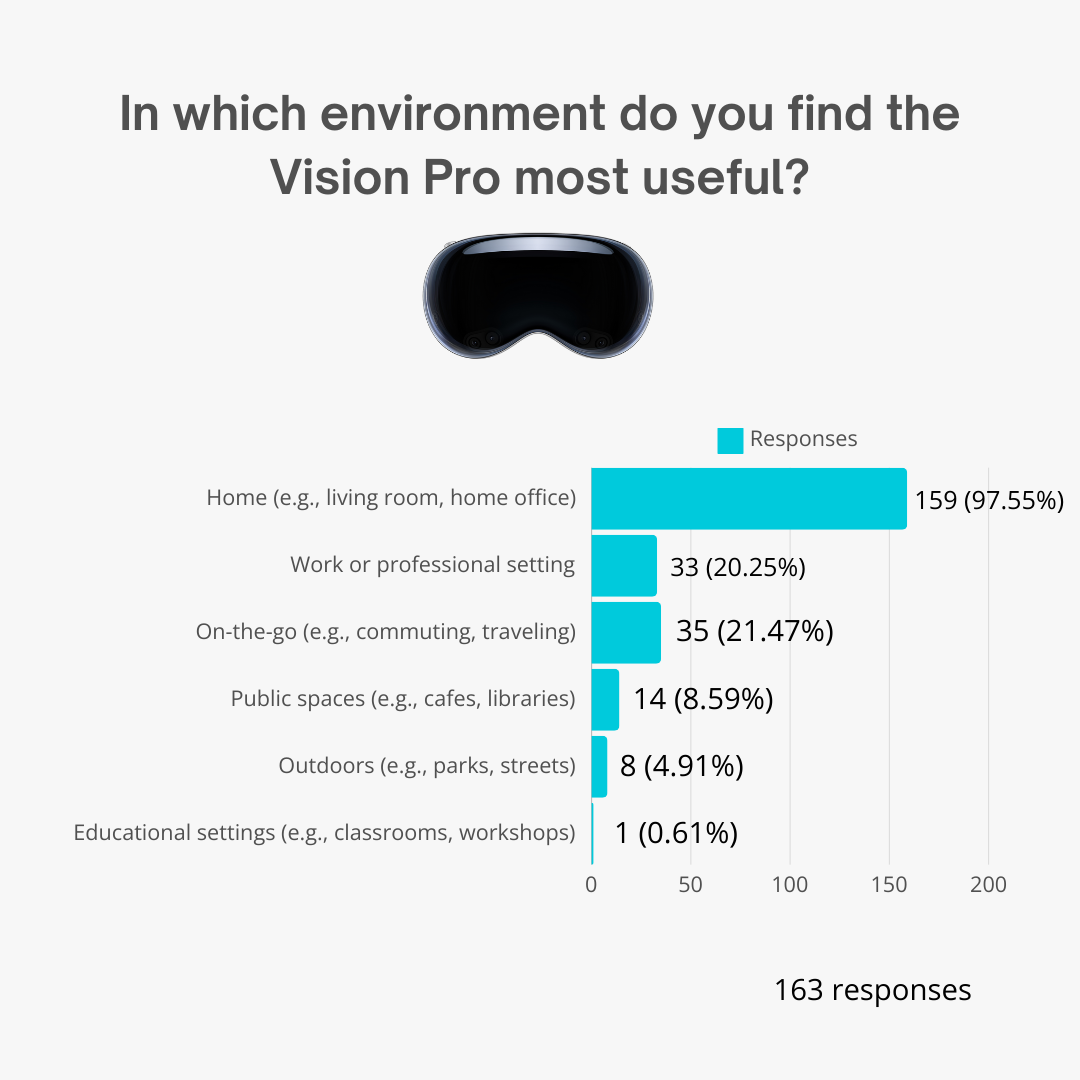
Home (e.g., living room, home office): 159 (97.55%)
Work or professional setting: 33 (20.25%)
On-the-go (e.g., commuting, traveling): 35 (21.47%)
Public spaces (e.g., cafes, libraries): 14 (8.59%)
Outdoors (e.g., parks, streets): 8 (4.91%)
Educational settings (e.g., classrooms, workshops): 1 (0.61%)
What feature or capability of the Vision Pro do you think is underutilized or not well-known?
Summary of responses:
Spatial features: Many respondents mentioned spatial aspects, including Spatial Personas, spatial photos/videos, spatial audio, and spatial FaceTime calls.
Immersive experiences: Several people noted immersive content, such as 3D movies, immersive sports/concerts, and interactive videos.
Productivity features: The ability to use Vision Pro for work, including Mac virtual display, multitasking, and using it with physical keyboards and trackpads.
Gaming: Some respondents felt gaming capabilities were underutilized, mentioning both native and streamed gaming experiences.
Creative applications: 3D modeling, scene construction, and creative work were mentioned by several users.
Accessibility features: A few respondents highlighted accessibility options and using pass-through as a visual aid.
Environmental interactions: Features like viewing furniture in your space and physics-based apps that react to the environment were noted.
Ecosystem integration: Some mentioned integration with other Apple devices, such as AirDrop and FaceTime handoff.
Unique interactions: Hand tracking, gesture controls, and alternative input methods were mentioned as underutilized features.
Content creation: The ability to create spatial content, such as converting regular photos to spatial ones, was highlighted.
Overall, the responses suggest that while Vision Pro has many impressive features, users feel that certain areas - particularly those involving spatial and immersive experiences, productivity enhancements, and creative applications - have untapped potential or are not widely known.
What third-party apps do you use most often on your Vision Pro?
Summary of most frequently mentioned third-party apps:
Juno: 17 mentions
Disney+: 14 mentions
inSpaze: 13 mentions
Max (formerly HBO Max): 5 mentions
Apple TV: 5 mentions
Supercut: 4 mentions
Moonlight / Moon Player VR: 4 mentions
Slack: 4 mentions
Netflix: 3 mentions
Microsoft Teams: 3 mentions
What's the most creative or unconventional way you've used the Vision Pro?
Here are the top 10 most unconventional or creative uses of the Vision Pro based on the survey responses:
Using first-person view sharing to get medical assistance for splinting a broken finger.
Hosting a virtual cooking club where the host streams food preparation in real-time.
Composing music at the piano while using Mac virtual display and overlooking a virtual Yosemite environment.
Using it to locate water damage in a house by placing a music player window at the suspected spot and viewing it through walls/floors.
Taking virtual piano lessons where the student streams their view to the teacher, showing both the music sheet app and hand movements.
Creating custom immersive environments and viewing gaussian splat renders for relaxation or entertainment.
Using the Da Vinci Eye app to trace images only visible in the Vision Pro for artwork creation.
Conducting silent writing sessions on Zoom where other participants can see the user's avatar.
Working from a campsite in a state park, using multiple virtual displays and operating Windows through Parallels on a MacBook.
Recording spatial video of special events like solar eclipses.
Part 3: Satisfaction
On a scale of 1-10, how satisfied are you with your Vision Pro overall?
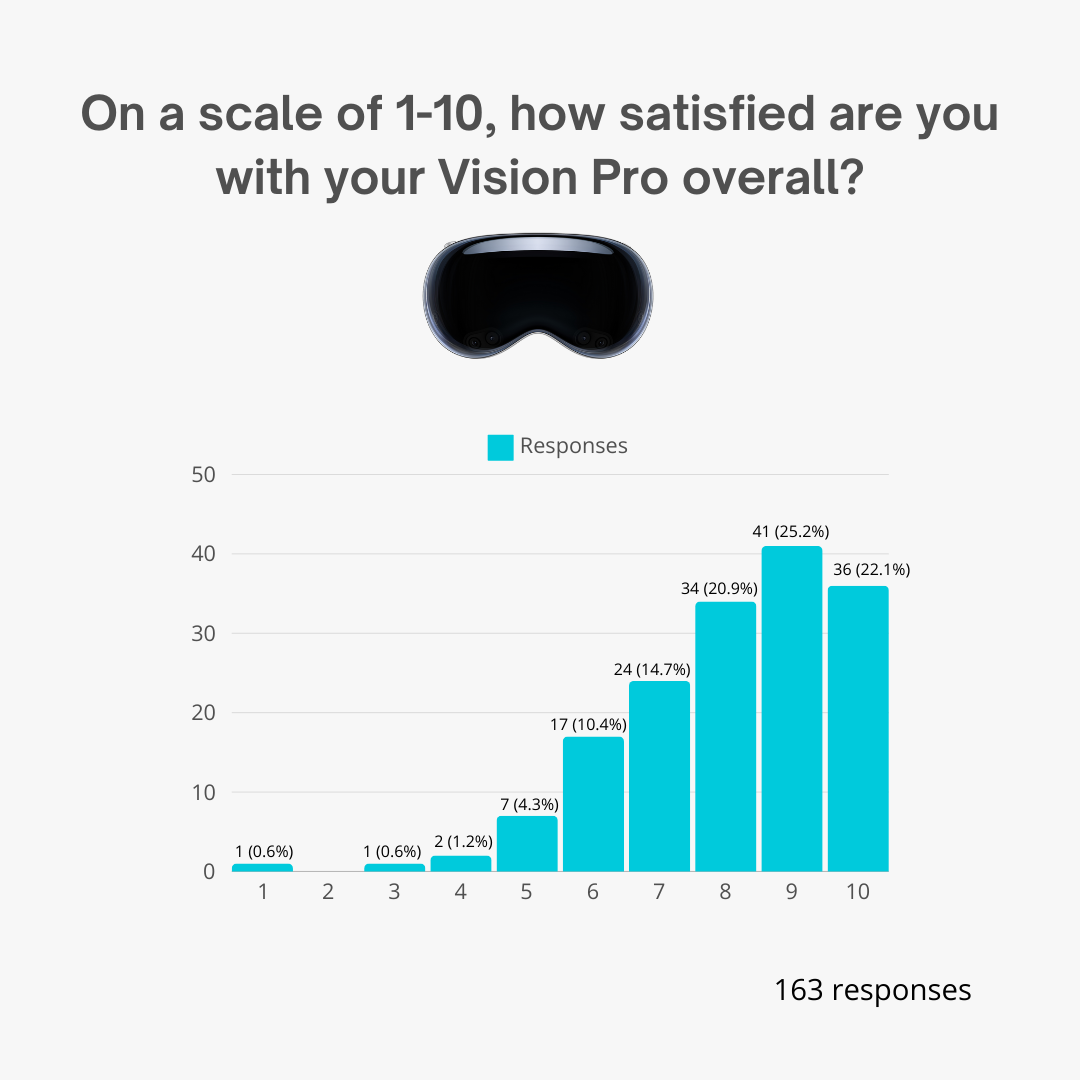
The survey results show a high level of satisfaction among Vision Pro users. A significant majority (68%) rated their satisfaction between 8 and 10, with 25.2% giving it a perfect 10. Only 3% of users rated it below 5, indicating a very low dissatisfaction rate. The average rating was an impressive 8.2 out of 10. This suggests that despite some frustrations, most early adopters are very pleased with their Vision Pro experience, recognizing its innovative features and potential while acknowledging its first-generation limitations.
What do you like most about the Vision Pro?
Users highlighted several key aspects they appreciate about the Vision Pro:
Display Quality and Immersive Environments: Many users praised the stunning visual fidelity and the ability to work or relax in various virtual settings.
Apple Ecosystem Integration: The seamless connectivity with other Apple devices was frequently mentioned as a significant advantage.
Spatial Computing Interface: Users expressed enthusiasm for the innovative user interface and the spatial arrangement of apps and windows.
Media Consumption Experience: The Vision Pro was often described as offering a superior experience for watching movies and TV shows, with users likening it to having a personal home theater.
Productivity Enhancement: The ability to have multiple virtual screens and multitask effectively was highlighted as a major benefit, especially for work-related tasks.
Technological Innovation: Many users expressed excitement about being at the forefront of what they see as the future of computing.
Image and Sound Quality: The high-resolution displays and spatial audio were frequently praised for their immersive qualities.
Ease of Use: Despite being a new type of device, many users found the Vision Pro intuitive and easy to navigate.
What aspects of the Vision Pro do you find most frustrating or limiting?
While users generally expressed high satisfaction, they also identified several areas of frustration or limitation:
Weight and Comfort: The most common complaint was about the device's weight, especially during extended use. Many users reported discomfort after wearing it for long periods.
Battery Life: The short battery life and the inconvenience of the external battery pack were frequently mentioned as limitations.
Limited App Ecosystem: Users expressed frustration with the lack of native apps for popular services like YouTube and Netflix, as well as a general shortage of immersive or spatial content.
Passthrough and Camera Quality: The quality of the passthrough view, especially in low light conditions, was a common point of criticism. Some users found it difficult to interact with physical objects while wearing the device.
User Interface and Control Issues: Some users reported difficulties with the precision of hand controls and gestures, as well as challenges with text input and cursor movement.
Price: The high cost of the device and its accessories was mentioned as a significant barrier to adoption and upgrades.
Social and Sharing Limitations: Users noted difficulties in sharing the Vision Pro experience with others and some felt isolated when using the device in social settings.
Software and OS Limitations: Some users, particularly developers, mentioned limitations in the operating system and development tools.
Hardware Issues: Glare, light leakage, and motion blur were reported by some users as detracting from the overall experience.
Content Creation and Sharing: Difficulties in creating and sharing content directly from the device were noted by some users.
Despite these frustrations, the overall sentiment remains positive, with users viewing the Vision Pro as a groundbreaking device with significant potential for future improvements and applications.
Part 4: Impact and Comparison
Has the Vision Pro replaced any other devices in your daily life? If yes, which ones?
Out of 134 respondents, about 60% (approximately 80 respondents) indicated that the Vision Pro has started to replace other devices in their daily lives. The most commonly replaced devices include:
iPad: Many respondents noted that the Vision Pro has taken over tasks they previously handled on their iPads, especially for media consumption (movies, TV shows), browsing, and light productivity.
MacBook/PC: Some respondents shared that Vision Pro’s ability to function as a virtual workspace has reduced their reliance on MacBooks or PCs. They highlighted using Vision Pro for multitasking, virtual displays, and productivity apps.
TVs: The immersive viewing experience of the Vision Pro has led several respondents to opt for it over traditional TVs for watching movies, shows, and immersive content.
Gaming Consoles: A smaller portion of users mentioned that the Vision Pro has started replacing their gaming consoles, thanks to its VR/AR gaming experiences.
Monitors: Some respondents are using Vision Pro to replace external monitors, leveraging its virtual display features for work or entertainment purposes.
Headphones: The spatial audio feature of the Vision Pro has minimized the need for separate headphones, particularly for media consumption and work.
Which of the following devices have you used before owning or using the Vision Pro?
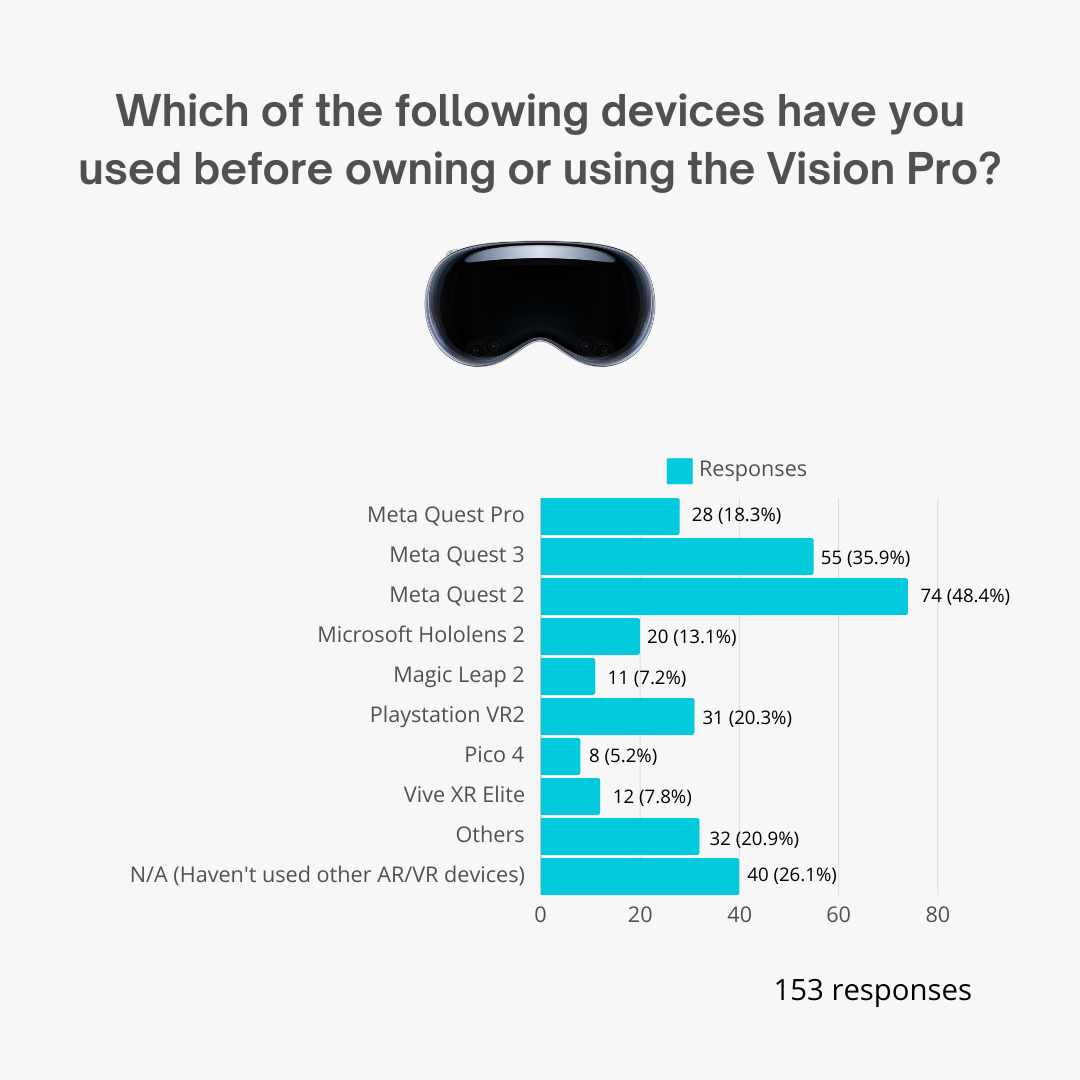
Based on 153 responses, the following devices were most commonly used by Vision Pro owners before adopting the device:
Meta Quest 2 was the most popular, with 74 respondents (48.4%) reporting prior experience.
Meta Quest 3 was used by 55 respondents (35.9%).
PlayStation VR2 was another popular device, used by 31 respondents (20.3%).
Other notable devices included:
Meta Quest Pro: 28 respondents (18.3%)
Microsoft HoloLens 2: 20 respondents (13.1%)
Magic Leap 2: 11 respondents (7.2%)
VIVE XR Elite: 12 respondents (7.8%)
Interestingly, 40 respondents (26.1%) had not used any other devices before the Vision Pro, indicating a significant portion of new adopters.
This data shows that many Vision Pro users had prior experience with AR/VR devices, particularly in the Meta Quest ecosystem, but there is also a substantial group of users who are newcomers to this technology.
How does the Vision Pro compare to other AR/VR devices you've used?
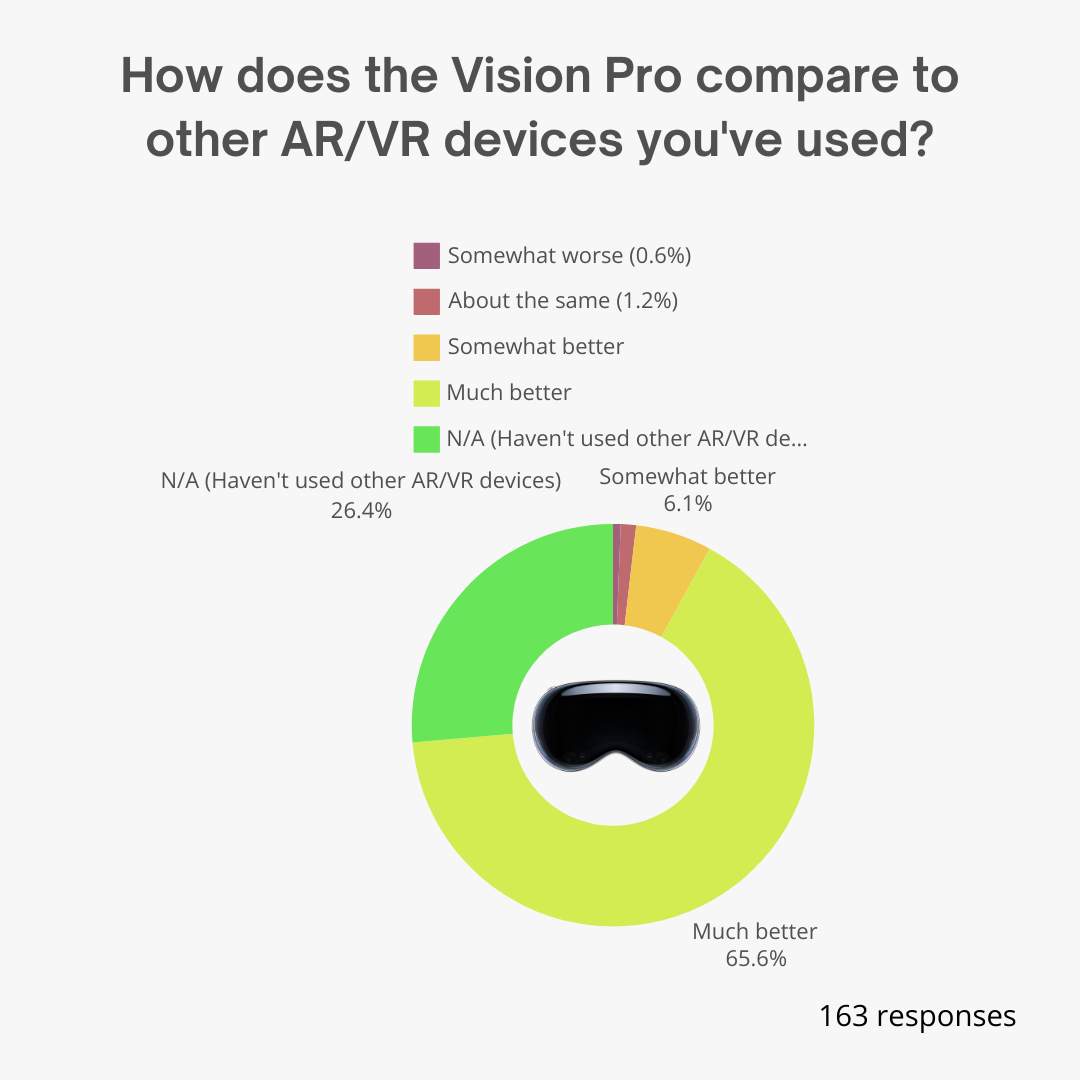
Based on 163 responses, here's how Vision Pro users compared the device to other AR/VR headsets they've previously used:
65.6% of respondents said the Vision Pro is "Much better" than other AR/VR devices they've used, reflecting a strong positive reception of the Vision Pro’s capabilities.
6.1% of respondents felt it was "Somewhat better", suggesting that while it improves upon existing technology, it may not be a groundbreaking leap for some users.
1.2% rated it "About the same" as other AR/VR devices.
0.6% of respondents found it to be "Somewhat worse" than their previous devices.
0% of respondents chose the "Much worse" option, indicating that no one found the Vision Pro to be significantly worse than other devices.
26.4% of respondents selected N/A (Haven't used other AR/VR devices), indicating that they are first-time AR/VR users with no prior comparison.
What features or improvements would you like to see in future versions of the Vision Pro?
122 respondents provided a wide range of feedback on features and improvements they would like to see in future versions of the Vision Pro. The most frequently mentioned suggestions include:
Improved Battery Life: A significant number of respondents expressed a desire for longer battery life, as current usage is somewhat limited due to the need for frequent recharging during extended sessions.
Lighter and More Comfortable Design: Many users suggested reducing the weight of the headset and improving its comfort, especially for long-duration use. A lighter design would enhance the overall user experience.
Better App Compatibility: Several respondents mentioned the need for improved app compatibility, especially with popular productivity, entertainment, and creative applications. More native apps and enhanced third-party support were common requests.
Wider Field of View (FOV): Some users requested an expanded field of view to make the immersive experience even more engaging. A wider FOV would help reduce the feeling of tunnel vision in VR environments.
Augmented Reality (AR) Enhancements: Respondents asked for more robust AR capabilities, including better object tracking, more interactive AR experiences, and improved blending between real and virtual worlds.
Eye and Hand Tracking: Users called for more advanced eye and hand tracking features, with some suggesting improvements in accuracy and responsiveness. These features are seen as crucial to making the Vision Pro more intuitive and hands-free.
Lower Price Point: A number of respondents mentioned the high cost of the Vision Pro as a barrier to entry and suggested that future versions should aim to be more affordable to reach a broader audience.
External Display Support: Some respondents expressed a desire for the Vision Pro to function more seamlessly as an external display for devices like MacBooks and iPads, allowing for more versatility in professional and creative work.
Gaming Improvements: While not a primary focus of the Vision Pro, some users wished for better gaming support, including more game titles, higher frame rates, and enhanced controller compatibility for an improved gaming experience.
Customizable Fit: A few respondents asked for more adjustable straps or interchangeable padding to make the Vision Pro more comfortable for a wider variety of head shapes and sizes.
Which other Apple devices do you currently own and use regularly?
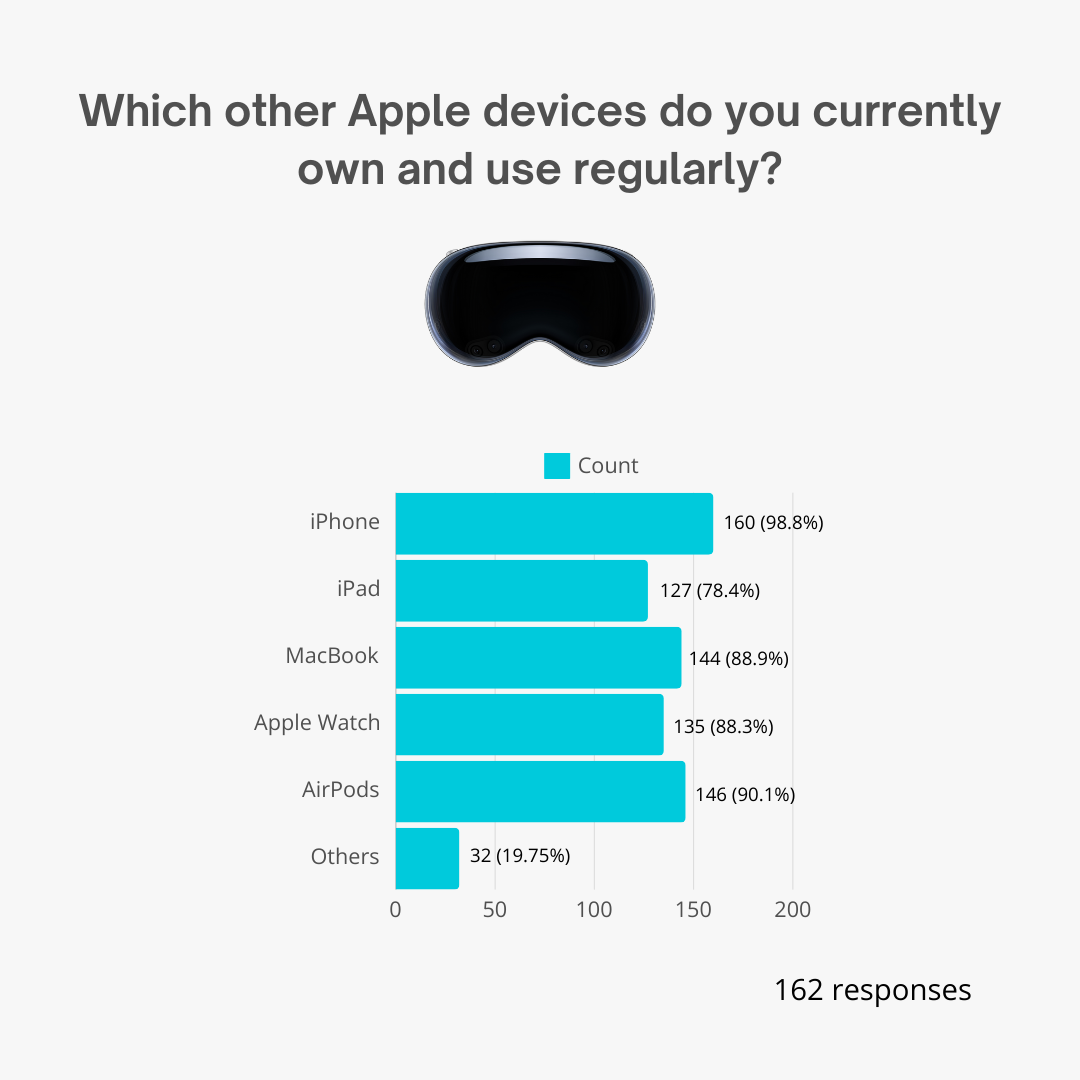
Out of 162 respondents, the majority reported owning and regularly using other Apple devices. Key findings include:
98.8% use an iPhone.
88.9% use a MacBook.
90.1% regularly use AirPods.
88.3% use an Apple Watch.
78.4% use an iPad.
19.75% reported using other Apple products.
These results show that Vision Pro users are highly integrated into the Apple ecosystem, with most respondents relying on multiple Apple devices in their daily routines.
Part 4: Demographics
What is your age?
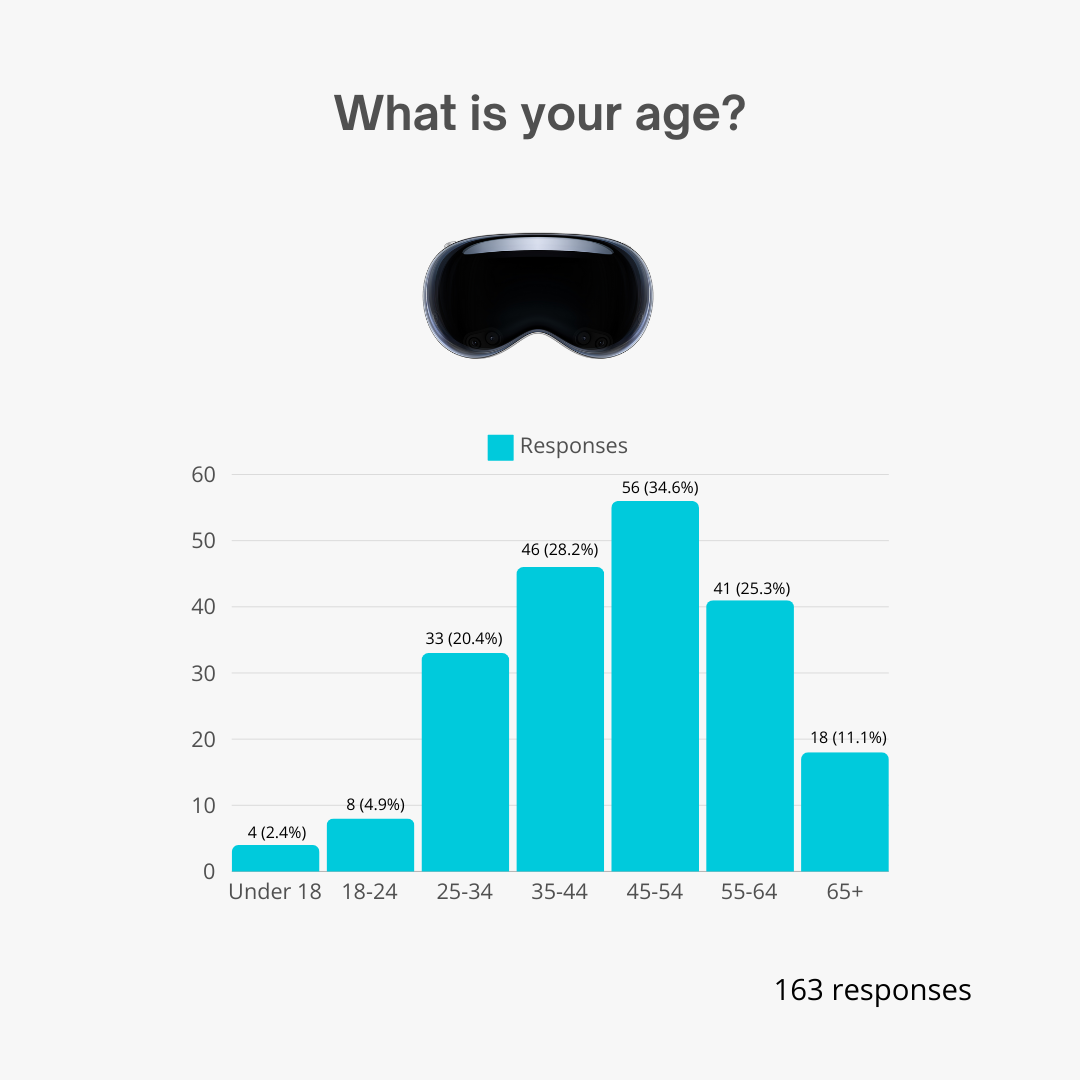
The majority of respondents fall within the 45-54 age range, making up 34.6% of the total. Other significant age groups include 35-44 (28.2%) and 55-64 (25.3%). Younger respondents, aged 25-34, account for 20.4%, while a smaller number are under 18 or over 65.
What is your occupation?
The survey respondents (163) represent a diverse range of occupations, with a notable concentration in technology-related fields. Here's a breakdown of the main categories:
Technology and Software (65 responses, 40%):
Software Engineers/Developers
IT Professionals
Systems Engineers/Architects
VR/AR Developers
CTOs and Tech Managers
Business and Entrepreneurship (24 responses, 15%):
Entrepreneurs
CEOs/Founders
Business Owners
Consultants
Creative and Design (16 responses, 10%):
Designers (Product, Graphic, Digital)
Photographers
Writers/Illustrators
Finance and Business Services (13 responses, 8%):
Financial Advisors
Accountants
Asset Managers
Education and Research (8 responses, 5%):
Students
Professors
Tech Educators
Healthcare (5 responses, 3%):
Doctors
Medical Students
Retired Individuals (11 responses, 7%)
Other Diverse Occupations (20 responses, 12%):
Lawyers
Urban Planners
Factory Workers
Truck Drivers
Marketing Professionals
Where are you from? (Country)
The survey received responses from 163 Vision Pro owners across various countries. The distribution is as follows:
United States leads with 98 respondents (60.1%), followed by the United Kingdom with 16 (9.8%), and Canada with 12 (7.4%). Germany accounts for 6 respondents (3.7%), while Australia has 5 (3.1%). France follows with 4 respondents (2.5%).
Spain and Singapore each have 3 respondents (1.8% each). Portugal, Brazil, and India each have 2 respondents (1.2% each).
Several countries have a single respondent (0.6% each): Italy, Egypt, Switzerland, Austria, Azerbaijan, Saudi Arabia, Sweden, Hong Kong, and Saint Lucia.
Lastly, 2 responses (1.2%) fall under the "Other/Not specified" category, which includes an unspecified Asian country and one not specified response.
This distribution shows a strong concentration in North America and Europe, particularly in English-speaking countries, with some representation from various other regions around the world.
How would you rate your tech-savviness?
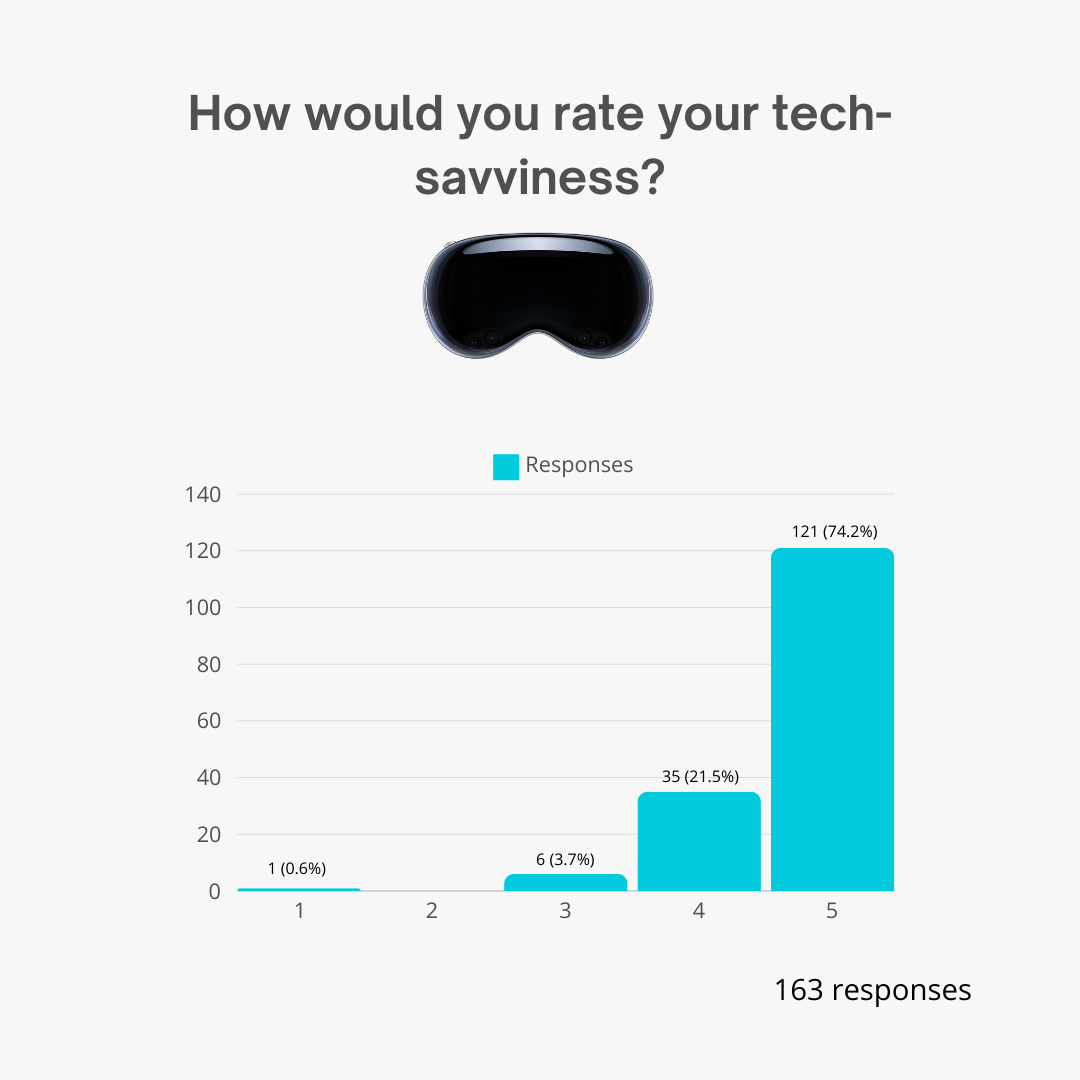
The vast majority of respondents rate themselves as highly tech-savvy. Out of 163 responses:
74.2% (121 respondents) rated their tech-savviness as a 5, indicating a high level of confidence with technology.
21.5% (35 respondents) rated themselves as a 4.
Only 3.7% (6 respondents) gave a rating of 3, and 0.6% (1 respondent) rated themselves as a 1.
Notably, no one rated their tech-savviness as a 2.
This suggests that the survey respondents are predominantly advanced technology users.
Conclusion
This survey of 163 Vision Pro users offers valuable insights into the early adoption and usage patterns of Apple's spatial computing device. While the results suggest a strong positive reception among these early adopters, it's important to contextualize these findings within the limitations of our sample.
The survey respondents were primarily tech-savvy individuals from technology-related fields, with 95.7% rating their tech-savviness as 4 or 5 out of 5, and 40% working in tech-related occupations. Additionally, 60.1% of respondents were from the United States. This demographic profile suggests that our findings may be skewed towards the experiences of tech-enthusiastic early adopters, primarily in the US market. As such, these results may not be fully representative of the broader potential user base for the Vision Pro.
Despite these limitations, the survey highlights both the current strengths of the Vision Pro and areas for potential growth. Users consistently praised the device's high-quality displays, immersive experiences, and seamless integration with the Apple ecosystem. While concerns about weight, comfort, battery life, and the current app ecosystem were noted, these are common challenges for first-generation devices and present clear opportunities for future enhancements. The fact that users are already identifying these areas suggests a high level of engagement with the platform and a desire to see it evolve.
Perhaps most encouragingly, many respondents reported that the Vision Pro is beginning to replace other devices in their daily routines, from tablets and laptops to traditional TVs. This trend, coupled with the creative and unconventional uses described by some users, hints at the transformative potential of spatial computing. However, it's worth considering that this high level of device substitution might be influenced by our sample's tech-enthusiasm and may not immediately translate to less tech-savvy users.
The survey results align with the optimistic outlook many have for the Vision Pro as a new platform. There appears to be a strong community of early adopters, especially developers, who are eager to help shape the future of the Vision Pro product line. This enthusiasm and willingness to engage with the technology bodes well for its continued development and adoption.
Subscribe to my newsletter
Read articles from Tom Krikorian directly inside your inbox. Subscribe to the newsletter, and don't miss out.
Written by

Tom Krikorian
Tom Krikorian
XR Developer - Currently building apps for the Vision Pro ᯅ